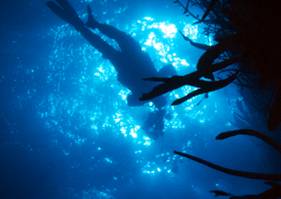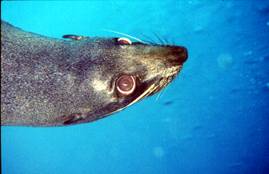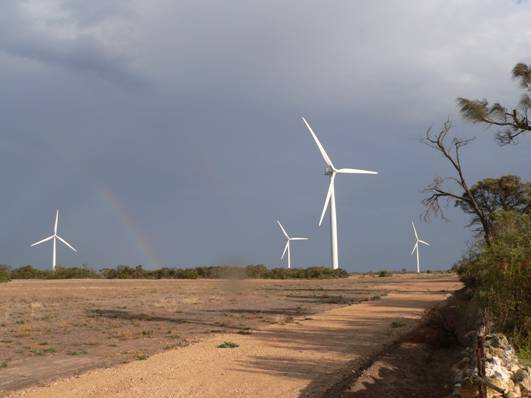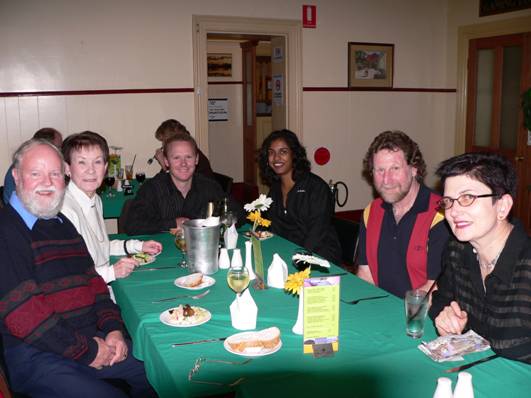Marine
Life Society of South Australia Inc.
Newsletter
July
2005 No.
323
“understanding, enjoying & caring for our
oceans”
Next Meeting
This
will be held at the Conservation Centre, 120 Wakefield Street, Adelaide
on Wednesday
July 20th commencing at
7.30pm.
Our
guest speaker will be Will Zacharin
who will be speaking
on the topic of the Sustainable Management of Fisheries
.
Will was
unable to address our June meeting owing to a computer
failure.
Contents
Diving
the Apple Isle Part 2
More
About The Booya
Library
Update
2005 June Long
Weekend at Edithburgh
Anniversary
Trophy
The trophy was
awarded this year to Geoff Prince for his untold
hours of work on the MLSSA calendars since its start in 1999. Although employed
by our printers, Printnow, he spends much of his own time making sure each
edition is correct and is the best possible.
A further
thank you was made to Phill McPeake and Danny Gibbins for their work on recent
calendars with the presentation of a bottle of wine to each.
ARTICLES
Newsletter
and Journal articles are still needed. Please send any contributions in by
Email, letter or give to me at a Meeting.
2006
Calendar
This
is now available. AUS$8 to members and AUS$10 to non
members. Please buy as many as possible and also sell to anyone who
is interested.
We almost sold every
2005 calendar! A wonderful
effort.
People
who have seen the new edition say it is our best yet.
This
Newsletter
The hardcopy of the Newsletter is in black and white as usual. If members prefer a colour PDF version then please email me.
by
Chris Hall
Part
2
On the
way back down to the jetty for the next dive we heard over the two way radio
that some orcas (killer whales) had been sighted. While waiting for the boat I
collected a few oysters from the jetty pylons and very nice they were too. When
the boat arrived, it was a little late so, we hurriedly organised the dive gear
in anticipation that we might get a glimpse of the orcas.
As we
reached the northern point of Waterfall Bay we slowed down and searched the
swells for any sign of these magnificent mammals. Then all of a sudden this
large fin appeared about twenty metres from the boat, Pete and I dashed for our
cameras with the hope we might get some good shoots. I had great difficulty
managing my housed camera with strobes hanging off each side in the huge swells
but Pete with his lighter and more manageable digital camera thought he’d got a
couple of good shoots. There were three orcas, two adults and a younger one.
They came within about three metres of the boat, just awesome to watch. At one
stage there was an Australian fur seal swimming amongst them so obviously they
all must have been feeding on a large school of fish. After about ten minutes
they went on their way so we headed into Waterfall Bay.
Although
we dived a different spot in the bay it was very
similar to our previous dive without the weedy seadragons; however we were
visited a numbers of times during the dive by some large rays. Again we
exhausted our air before surfacing. A very enjoyable
dive.

Diving
this part of Tasmania is very similar to the northwest coast of Ireland except
for the fish life.
Back at
dive centre, warm and showered Lorna offered to cook some scrambled eggs while
Pete downloaded his photos onto his laptop. I had to wait until I got back to
Adelaide to see my results as there was nowhere to get my slides processed and
mounted. I’m slowly seeing the advantages of digital cameras. So while eating
delicious scrambled eggs we were treated to a slide show of Tassie’s marine life
including orcas.
That evening we sat
around the dinner table at the local hotel telling tales and discussing a great
day’s diving and arranging tomorrow’s dives. It was decided that seven of us
would dive the Nord, so another early start. This dive is for deep divers
experienced to 40 metres and considered by some as one of Australia’s best wreck
dives.
The SS
Nord formerly the Maria Goriainova was built in the
Grangemouth and Greenock shipyards in 1900 and was registered in London to the
Anglo-Saxon Petroleum Company. 80 metres long and 1057 tons she was powered by a
201 horsepower triple expansion steam engine, from twin boilers, driving a
single screw (propeller).
On
November 7th 1915 she was on her way from Melbourne to Hobart with a
cargo of 12,000 cases of benzine used for fuelling cars at the time. Whilst
trying to shelter from heavy seas she cut between the Hippolyte Rocks and hit
Needle Rock at 5pm which sticks up from the ocean floor two metres from the
surface. It is thought that the same rock claimed the SS Tasman in 1883.
Captain
Mackay decided to head for Port Arthur but with such heavy seas she was not
making way so a decision was made to beach her in Fortescue Bay. Rising waters
extinguished the boilers so orders were given to let out the port anchor to
secure the ship. All in all about 100 metres of anchor chain was let out but the
ship drifted towards shore, it was then that the order was given to abandon
ship. At 7.15pm the lifeboats were lowered and the crew headed for safety. Some
of the Chinese crew made it to shore and walked to Port Arthur while the rest
were spotted by a lighthouse keeper who saw the plight of the Nord and went to
their assistance.
2am
November 8th 1915 finally saw the demise of the Nord as she sank some
nine hours after striking rocks off the Tasman Peninsula where she lays upright
in 40 metres of water.
The day
greeted us with clear skies and calm conditions. It couldn’t have been better
planned for the long trip to the Nord. We kitted up, loaded the trailer and
braved the trip down to the jetty in the less than reliable ‘troop carrier’. We
transferred our gear from the trailer to the boat and got underway. Gary the
skipper took the helm and the seven divers settled down in the boat to view the
spectacular scenery of the Tasman Peninsula.
About 40
minutes later we arrived at our destination, Gary located the wreck and lowered
the anchor. Once at anchor we kitted up, Gary carried out the dive brief and we
entered the water-cold! About half way down the anchor chain we were entertained
by an Australian fur seal skimming passed us and trying to bite our fins. At
this point I looked down and could see the faint outline of the Nord, we had
about 20 metres visibility. On we descended to a reef at 35 metres and about
5-10 metres from the stern of the wreck. The ship is in two main parts with
stern at 40metres and the bow at about 42 metres. The middle of the ship is
collapsed and is a haven for fish and invertebrates alike.
The
stern which is most intact is covered with algae, sponges, anemones and these
most beautiful yellow zoanthids. Amongst the wreckage swim common bullseyes,
butterfly perch and a gurnard perch sat motionless on a steel rib. Above us the
fur seal was darted and cavorted amongst our exhausted bubbles. I went down to
look at the prop and registered 38.8 metres on my dive computer. I then headed
up the anchor chain and was again entertained by the fur seal as it darted and
swooped for our fins. It made it a very interesting safety stop. It was a great
dive, probably one of the best wreck dives I’ve done in Australia but not quite
as good as some of the wrecks I’ve dive in Ireland.
Back on
board we readied for the trip back. The sea was now dead calm and the sky blue,
with a warm sun slowly returning the warmth to our bodies. Gary steered the boat
close to the cliffs as they towered above us and we got the full impression of
their height, up to 300 metres in some places.

After
completing about a third of the trip Gary slowed down and steered close in to
the cliffs to view some of the amazing rock formations amongst the cliffs, the
Totem Pole and the Pinnacle. These narrow rock formations rise straight out of
the sea for hundreds of metres. Those that had digital cameras indulged
themselves in a photo shoot and those that didn’t just looked on
enviously.
The rest
of the trip back passed quickly as Gary and I swapped stories of our time in the
RAN (Royal Australian Navy).
Back at
base we had time to relax and eat before the next dive.
Part of
Waterfall Bay has a system of caves that burrow into the cliffs and this was to
be our next dive, the Cathedral Caves. These caves can be seen from the surface
at the southern point of Waterfall Bay. Some of the caves are over 100 metres in
length and can vary from a tight squeeze to accommodating 4-5
divers.
Back at
Waterfall Bay and anchored, Gary gave us an extensive dive brief as there had
been a fatality in the caves about a year or so ago. Gary was to lead the dive
and explained that anyone that didn’t have at least a 100 bar going into the
last cave would have to remain outside.
Once in
the water we descended as Gary led and the rest followed in single file. As we
entered the first cave the entrance narrowed and it became a little unnerving
but as soon as you got used to the torch light in the dark it became more
relaxed. There were a few tight squeezes where tanks banged against the roof of
the cave. The floor of the caves is made up mainly of rock with some sand so
silting wasn’t a problem. We explored Skull Cave, so named because of the two
large eye shaped entrances and then the Catacombs which is much tighter and
guaranteed to produce a few scrapes. In one cave there are some fossils while
all of them had crayfish and the usual array of invertebrates. At the entrance
to the third and last cave, the Dog Leg, Gary checked our contents gauges to
make sure we had the obligatory 100 bar. Once checked out it was on with the
cave exploration. This was a relatively simple task as I followed Gary and where
the cave turned to the left he ushered me on while directing the others. Once
you turned the corner you could see daylight and the way
out.
We all
gathered at the exit of the cave and those that had enough air left continued
the dive to observe some more intriguing marine life.
When we
got back to dive centre we cleaned our gear and help prepare for the BBQ that
evening while Pete collected a lot of rubbish and wood for the bonfire.
The sun
was sinking in the west and evening closing in as John flashed up the barbie and Pete put a light to the
bonfire. Soon the chops, sausages and hamburgers were sizzling away under the
watchful eye of the ‘Chef’-John while the rest of us stood around salivating as
the cooking aromas wafted through the night air.
The call
came “grubs up” and there was a rush of starving people for the BBQ’d meat and
salads. We all sat around the bonfire eating, drinking and having our fill. As
we sat back chatting and relaxing a brilliant full moon rose in the east
cascaded by a billion twinkling stars. This was a perfect end to a magnificent
day.
PICTURES
by Chris Hall
To be
concluded
by
Steve
Reynolds
In an earlier
article titled “Cyclone Tracy Shipwrecks” I wrote about a schooner called the
Booya. I have since found more details about the Booya in Captain
James Gillespie’s book “Traders Under Sail – The
cutters, ketches and schooners of South Australia”. Page 24 of this book
features a great photo of the Argosy Lemal (the earlier name for the
Booya) and one of her sister ship De Wadden on page 25.
Captain James Gillespie’s book says that in 1920 the Argosy Lemal
was registered in Newcastle on Tyne in England by the Argosy Shipping and Coal
Co. She came to SA and was registered at Port Adelaide in 1923. She was owned by
Yorke Shipping Pty Ltd but they were later a subsidiary of the Adelaide
Steamship Co Ltd. Gillespie says that she was then managed by MB Crouch of Port
Adelaide (Reginald M Crouch of Adelaide became her new owner in 1949). She
became well known in SA waters. In the mid-1930s she carried bags of malted
barley from SA outports to Melbourne. Captain Gillespie was an able seaman on
her for six months at that time. She would carry about 100 tons of bagged
Geelong cement when she returned to Port Adelaide from Melbourne. When she was
requisitioned by the Commonwealth Government in November 1942, she was used in
New Guinea waters during World War II. After the war she briefly became known as
the Ametco (acronym for “Australian
Middle East Trading Company”). In my earlier article titled “Cyclone Tracy
Shipwrecks” I wrote that “Reginald M. Crouch of Adelaide became her new owner in
1949 and she was registered in Melbourne as the Claire
Crouch.
Captain
Gillespie agrees with that on page 48. On page 24, however, he says that Crouch
became her new owner in August 1956 (not 1949). There is a great photo of the
Claire Crouch in Hobart on page 49 of Gillespie’s book. According to
Gillespie she successfully traded between Port Adelaide and Hobart for some
years before being converted to an acid carrier. Special acid carrying tanks
were installed in her cargo hold so that she could carry sulphuric acid from
Port Pirie to Port Lincoln for some years. She was then sold to new owners in
Townsville, Queensland in 1968. This is when she was renamed Booya and
became a fuel supply vessel to a north Queensland prawning fleet. This, it seems, is what led her to Darwin
Harbour where she was wrecked during Cyclone Tracy on Christmas Day 1974. Now I
trust that I haven’t confused readers too much with so many names (name
changes). I myself have struggled with a few problems on this topic. For
example, in my “Cyclone Tracy Wrecks” article I questioned the spelling of
Lemal, thinking that it had been spelled as ‘Lemael’ in some source. I found a photo of a schooner
called Lemael in “The First 100 Years of
Semaphore 1883-1983” and thought that it was actually the Argosy Lemal.
The poor photo in the Semaphore Centenary booklet looked very much like the
one of the Argosy Lemal on page 24 of Captain Gillespie’s book. The
caption in the Semaphore Centenary booklet reads “3 masted schooner “LEMAEL” washed ashore in front of Wolverton in 1901 storm, Largs
Jetty in background”. I was excited to discover that “Wolverton” was recently the Lefevre Peninsula Hospital on the Esplanade at Semaphore.
The reason for this was that I once lived across the road from the hospital (in
a side street). What a fantastic coincidence to discover that the Argosy
Lemal (or Lemael) had at some stage washed
ashore on my ‘doorstep’. My excitement soon subsided when I checked “South
Australian Shipwrecks – A Data Base 1802-1989” by Peter Christopher. That’s when
I found out that the Lemael was a two-masted
schooner built in Tasmania in 1892. She was then wrecked at Cape Banks in the
south-east of SA in 1921. And the Lemael had
washed ashore at Semaphore in 1901! It couldn’t be the Argosy Lemal which
had been built in 1917. But the Lemael that
washed ashore at Semaphore in 1901had three masts and the Lemael that was wrecked at Cape Banks in 1921 had just
two masts! It looks like more research is needed on this
subject.
REFERENCES:
“Traders Under Sail –
The cutters, ketches and schooners of South Australia” by Captain James
Gillespie, 1994.
“South Australian
Shipwrecks – A Data Base 1802-1989” by Peter Christopher. Published by The
Society for Underwater Historical Research, 1990.
ISBN 0 9588006 1
8.
“The First 100 Years of Semaphore 1883-1983” (A
Stroll Down Memory Lane” by Captain J Maitland Thomson), Semaphore Promotion and
Tourist Association Inc.
Library
Update
by
Steve
Reynolds
We
recently purchased several (seven) books to assist with the identification and
classification of marine creatures on the Photo Index slides. These books have
also been added to our library for limited loan by Society members. The books
purchased were: -
“Australian
Marine Life” by Graham J Edgar
“Seahorses,
Pipefishes and their relatives” by Rudie
Kuiter
“A
Guide to Squid, Cuttlefish and Octopuses of Australasia” by Mark Norman &
A.Reid
“A
Field Guide to Crustaceans of Australian Waters” By D.Jones & G.Morgan
“Marine
Flatworms, the World of Polyclads” by L.Newman & L.Cannon
“1001
Nudibranchs” by Neville Coleman
“2002 Sea Shells” by
Neville Coleman
“Seahorses,
Pipefishes and their relatives” has been added to the
Marine Fish book section of our library. This hardcover book by Rudie Kuiter is
‘a comprehensive guide to Syngnathiformes’. It covers
much more than just seahorses and pipefishes. There’s
a lot more fish in there than you would think.
The other six
books have been added to the Other Marine Life book section of our library.
“2002 Sea Shells” by Neville Coleman is a ‘catalogue of Indo-Pacific mollusca’. Neville’s “1001 Nudibranchs” is a ‘catalogue of
Indo-Pacific sea slugs’. “Australian Marine Life” by Graham Edgar covers both
‘plants and animals of temperate waters’. It is a revised edition (2003).
“Marine Flatworms – The World of Polyclads” by Leslie
Newman & Lester Cannon was a finalist for the (Reed New Holland 2003?)
Eureka Science Prize.
These books turned out
to be better than I imagined when ordering them from Mountain Ocean and Travel
Publications (through Dive Log). They gave us 10% discount off of all of the
books which was a great help. The books themselves have already been a great
help in identifying and classifying many of the slides of marine creatures in
our Photo Index.
2005 June Long Weekend at Edithburgh
by Philip Hall
After a break
of several years it was decided to restart the annual June Long Weekend trip to
Edithburgh following a suggestion by Chris Hall. This turned out to be a great
success, and those who did not come missed out big time.

Margaret and I
were the first to arrive on the Friday afternoon and quickly settled in at the
Caravan Park. We immediately noticed several changes to the area. The 55 wind
turbines got the first visit and then we looked at the boat ramp improvements.
The weather was not too bad, a little cold and windy with the occasional shower
providing us with great rainbows over the turbines. Chris and Ann arrived later
in the evening as did Talitha and Mark.
Saturday was
glorious and the divers were soon getting ready at the Edithburgh Jetty. Well,
Chris led the way and Mark and Talitha went in a little later. It was apparently
good diving with reasonable clarity. Chris and Mark took plenty of pictures of a
reasonable variety of marine life. Margaret and I went for a drive to Port
Moorowie and came back along the coast via Troubridge Hill. On the way we saw
whales spouting and breaching about a kilometre out to sea. The Whale Centre
reported sightings of Humpbacks moving west on Friday so these may have been the
ones we saw but more likely to have been some Southern
Rights.

That evening
we all retired to the Edithburgh Hotel for dinner where we were remembered by
the hostess. We had just finished an excellent (huge) meal when Kevin arrived.
So we sat down again and carried on chatting. How Kevin managed to eat with all
the talking I do not know.
Sunday started
well with Kevin and Chris diving under Wool Bay jetty and finding plenty of
Pipefish, Seadragons, Flatheads and other creatures to photograph. Margaret and
I went down to Stenhouse Bay where we found in the Ranger Station and
Information Centre a large information board with marine life pictures credited
to MLSSA. Then we went on to Pondalowie Bay to see all the changes there. Phill
and Barbara arrived at Edithburgh with their new boat whilst we were away and
then after dinner we spent the evening playing cards. Chris and Kevin had a
night dive under Edithburgh jetty but the viz was
poor.

Monday was a
bit changeable so Margaret and I went to Corney Point and on along the coast to
Turton to see all the changes there. Quite interesting what they have done to
the boat ramp! It was very windy and rough on that coast. We then went to
Hardwick Bay and across to Stansbury to complete the trip. No diving for the
others as they had to pack and return home except for Phill and Barbara who were
to go to Turton but changed their minds and decided to stay at
Edithburgh.
On Tuesday
Phill, Barbara, Margaret and myself went to the Marine Centre at Port Vincent
where we had a conducted tour of the Centre. Quite a lovely
place to learn about the marine environment. Margaret and I returned home
from there leaving Phill and Barbara to enjoy a further few days at
Edithburgh.
All in all an
excellent weekend with some good diving taking place. I hope more members and
friends will come next year as it certainly is worth the effort. We all know the
weather can be changeable but diving is usually possible one side of the
peninsula or the other.
Pictures by
Philip
Wind turbines
with rainbow.
Dinner (L to R -
myself, Margaret, Mark, Talitha, Chris, Anne).
Chris exiting at
Edithburgh on the Saturday.
Marine Life chart at
Stenhouse Bay Ranger Station—MLSSA credit at the bottom.